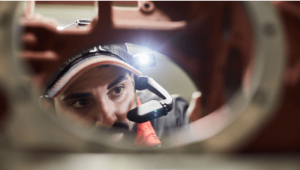How to Keep Your IIoT Projects From Failing
The Industrial Internet of Things (IIoT) uses data collection and analysis to help companies increase productivity while cutting costs. However, many IIoT projects fail.
Beecham Research found that almost 75% of IoT projects are not considered successful by the company that initiated them. The projects often run over budget, miss crucial deadlines, and fail to produce expected results.
To keep their IIoT projects from failing, companies need to start small, scale up, and get internal buy-in. Adopting Connected Worker technology is a great way to get started and demonstrate the value of your IIoT strategy.
Why IIoT Projects Fail

IIoT projects often fail because of a lack of internal backing. Companies tend to be wary about investing in new technologies. For example, many organizations were burned by large investments in cloud that didn’t work out. The economic impact of COVID has only exacerbated corporations’ fears about large investments in unproven technologies.
To develop winning IIoT projects, you must have internal buy-in, especially from the end users. The end users become champions for the technologies and help rapidly spread adoption. Without adoption, these projects can never succeed. End users might be hesitant to adopt to change, thinking this could displace some of their expertise. However, if anything it makes them more important to capture the knowledge and be able to perform other tasks while being much more effective and efficient.
IIoT projects are vulnerable to failure because they are complicated. These projects involve a lot of moving parts and expertise related to a wide variety of technologies. IIoT projects combine communications and computing technologies. Hardware, software, and connectivity need to work together with the cloud and edge devices to make IIoT work. Complex machinery must be equipped with beacons and sensors and connected to a robust network so data can be transmitted and processed in real time.
IIoT requires specialized knowledge that may be difficult to find. Applications need to be developed, tested, and deployed that achieve the goals of key industries, such as manufacturing, automotive, utilities, and oil and gas.
To succeed, organizations must avoid being swept away by the excitement of the growing IoT and IIoT market. Rushing along the path to digital transformation through IIoT can result in failure and frustration.
Building Successful IIoT Projects
Because IIoT projects can be complicated and hard to manage, you need to start small, prove value, and then scale. Building your IIoT strategy gradually and demonstrating ROI minimizes initial investments and ensures favorable cost-to-risk ratios throughout implementation.
Small, initial implementations can serve as a proof of concept to build upon. Like any large, ongoing project, IIoT projects should undergo a process of continuous improvement that takes advantage of performance metrics. Demonstrating return on investment (ROI) is always a great way to get line of business on your side for future IIoT projects. Whether it’s 3-6 months or whenever, we need to be able to show ROI on Key Performance Indicators (KPI) to prove the worth in not only continuing but also scaling.
Succeeding with IIoT requires this internal support. To create buy-in, you need to involve a wide representation of the company in the planning and solution development process. This means including C-level, management and, most importantly, the end users in the planning and decision-making process. The more involved the team is in developing the solution, the more likely they are to feel invested in its success and use it.
Getting Started With Connected Worker

Starting with a small IIoT project, such as Connected Worker, is a great way to start building the case for larger future investments. Connected Worker as a Service is a low-cost, simple-to-implement solution that easily demonstrates immediate impact and ROI.
Connected worker technology combines hardware and software to enable field workers to access data and communicate with co-workers through 2-way audio and video channels. It also reduces travel/truck rolls to get quicker time to repair and instant decisions. Connected Worker use cases and strategies will be unique to the business. Use cases include promoting safety, improving knowledge transfer, and enabling remote collaboration.
Companies should work with experienced domain expert integrators to assess the technology landscape and build customized solutions to meet their particular needs. Further investment in IIoT will be considerably easier to justify after demonstrating the impact of top solutions, such as CBT’s Connected Worker solution.
Customizing an IIoT Strategy
Don’t be one of those companies that feel their IIoT projects have failed. Focus on creating a custom IIoT strategy for your business.
IIoT and connected worker strategies are not one-size-fits-all. When choosing a systems integrator, your company should look for one that can work with you to assess readiness, define goals, and develop a personalized roadmap for IIoT implementation and scaling.
CBT is a domain expert integrator offering the information technology and operational technology convergence needed to support successful IIoT projects. We have the ability to customize software for connected worker technologies so your company can realize your unique vision for IIoT. We work with companies in a wide variety of industries to design and implement connected worker solutions that meet their needs.
Experience our Connected Worker solution firsthand. Request a demo from CBT.
